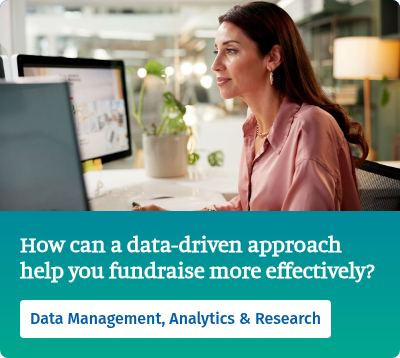3 Donor Insights That Are Most Important To Your Outreach

Imagine your fundraising team learns that one of its longest-standing donors is retiring. Do you ignore the news and continue sending fundraising appeals as usual? Or, do you make the effort to pick up the phone and congratulate them?
Even relatively small gestures like this one can go a long way in securing long-term donor engagement. Applying prospect research findings about important milestones enables your team to replace generic appeals with targeted and impactful communications. Ultimately, this is how you cultivate authentic relationships and a strong nonprofit community.
Let’s examine the most crucial donor insights to focus your efforts on, and how they drive effective outreach.
Real-Time Donor Insights
Donor outreach is like a navigation system: it needs up-to-date information to be effective. A GPS lacking current traffic data will inevitably provide an inaccurate estimated time of arrival—similarly, outreach lacking current donor insights results in irrelevant messages that fail to resonate.
Consider tracking the following timely insights:
Life Events
For your nonprofit, donor engagement and contributions are everything. However, for donors, your nonprofit is just one aspect of their hectic lives.
Using prospect research tools that alert your team to donor news and significant life events, you can connect with donors at the right time with the right message.
Relevant life events include:
- Birthdays
- Holidays
- Anniversaries
- Marriage
- Birth of a child
- Graduation
- Relocation
- Job changes
- Retirement
The right prospect research software will also help your team tap into historical donor data for a more complete view of your supporters.
For example, let’s say you know your donor’s wedding anniversary is on October 28. You might share a generic animated eCard via email to extend your congratulations. With historical data, on the other hand, you learn the donor is celebrating their 30th wedding anniversary, adding another layer of personalization. This significant milestone warrants more thoughtful outreach, like a gift basket or gift card.
Media Mentions
News and public information are excellent resources for donor insights. Monitor mentions of donors in the media to learn about:
- Philanthropic activity: Your nonprofit already has the data on a supporter’s activity with your organization, but what about their contributions to other causes? Media mentions may highlight the supporter’s other giving interests, helping your nonprofit align its fundraising appeals with their values.
- Obituaries: When a person connected to your nonprofit passes away, obituary data empowers your team to extend condolences, which in turn strengthens your relationship with the recipient. Insightful Philanthropy provides this example: If a long-time donor’s spouse passes away, sending your condolences demonstrates your team’s care for them beyond their financial contributions during a difficult time.
- Career-related events: News outlets frequently cover corporate events, such as company acquisitions or sales, SEC filings, and performance-based awards. Use this data to learn about donors’ careers and respond accordingly, whether congratulations are in order, or their company might make for a valuable partner to your organization.
Focus your research on local news outlets for the areas where your donors live. These resources can offer a closer look at the event, such as a hometown perspective of the donor’s success or interviews from close relatives.
Contextual Donor Data
An often-overlooked donor data analysis opportunity is considering the donor outside your organization. What are their giving habits, and who are they outside of their charitable contributions? The following donor insights are less personalized, but can surface general trends/patterns that influence your outreach.
Demographics
While demographics alone won’t fuel your fundraising strategy, this data can inform some important outreach decisions, such as:
- Communication channels: Different age groups or generations prefer various outreach methods, and your team can tailor its messaging accordingly.
- Focus of appeal: Some audiences are more likely to contribute monetarily, while others prefer to give in-kind donations or volunteer their time. Income level and employment data indicate which appeal is most successful.
- Message alignment: Geographic location, religion, education, and other factors can influence which causes resonate most with your audience.
Think of demographic data as a contextual understanding of your target audience. These insights may be surface-level, but they highlight general trends that can help you scale your outreach.
Giving History
A donor’s giving behavior offers insight into their loyalty and potential:
- Gift amount suggests a supporter’s position in the donor journey. Are they a small donor needing more engagement, or a major donor deeply committed to your cause?
- Donation frequency (i.e., one-time, monthly, annually, etc.) indicates a donor’s level of involvement with your nonprofit.
- Gift type signals a donor’s priorities, such as donating to a specific project or choosing a donation tier tied to a particular outcome.
These details can inform how your team advances donors through the funnel. For instance, a small, one-time gift might necessitate educational materials about your nonprofit’s formation. Mid-level, recurring donors could be promising candidates for upgrading, and major donors require thoughtful recognition strategies.
Engagement Metrics
For a comprehensive understanding of donors’ involvement and motivations, consider the non-financial ways donors remain engaged, including:
- Marketing responsiveness: Email open rates, social media likes and shares, and other interactions with your marketing content indicate a willingness to hear from and interact with your organization.
- Volunteerism: Supporters’ participation in volunteer activities demonstrates a deeper level of connection with your organization. According to CharityEngine, your volunteer management tools should track relevant data, like hours, attendance, and retention.
- Event attendance: Event attendance is a multi-faceted engagement indicator! Donors who attend your events are paying attention to your marketing materials, willing to purchase tickets, and making a conscious effort to carve out time in their busy schedules for your organization.
Your fundraising team should be prepared and equipped to consider engagement at every donor touchpoint. Make sure you’re using prospect research software that integrates with your constituent relationship management (CRM) system to consolidate all new and existing information about your donors.
Future Predictions
Considering the unpredictability of nonprofit revenue, it’s more important than ever to plan ahead financially. Donor insights not only supply ideas for immediate outreach, but can also give you a glimpse into their potential futures with your organization.
Take wealth data, for example. Instead of using this information to identify those with the current capacity to make a major gift, consider how wealth markers may impact the future:
- Real estate ownership: Supporters with significant real estate assets may be interested in planned giving options.
- Stock holdings: Financial capacity from stock indicates a potential for increased giving, especially during periods of market growth.
- Political giving: When donors demonstrate interest in local causes, your nonprofit can flag them as candidates for future advocacy campaigns.
For analytical support or help forecasting donor behaviors, consult a fundraising expert with experience in data management. These professionals can help you apply data insights to your communications, crafting an outreach strategy that effectively grabs donors’ attention.
Small- to mid-sized nonprofits can't afford to waste time on outreach that misses the mark. Actionable intelligence tells you when and how to engage, but it’s up to your nonprofit to apply these insights for effective outreach. Create an outreach strategy built on comprehensive donor data, and your supporters will be more excited than ever to engage with your nonprofit.


Comments
Questions or comments? Join the conversation!